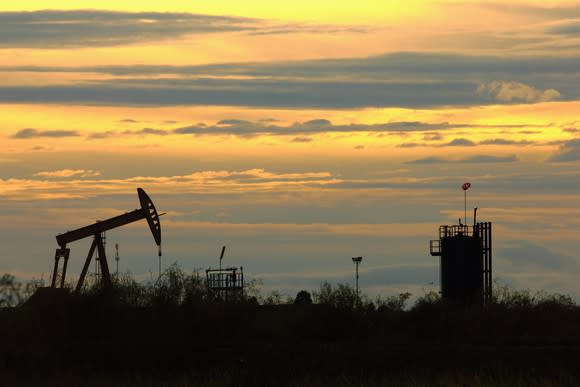3 Things Pioneer Natural Resources' CEO Wants You to Know About Its Future
While 2017 hasn't gone as Pioneer Natural Resources (NYSE: PXD) thought it would, the company has still delivered solid results. The recently completed third quarter wasn't any different as the shale driller smashed analysts' expectations despite several headwinds. That sets the company up for continued strong performance in the coming years.
That future was the focus of CEO Tim Dove's comments on the accompanying conference call. Overall, he made three points that made it clear that Pioneer has no plans to slow down.

Image source: Getty Images.
1. We're on track with our 10-year plan
One reason 2017 hasn't gone like Pioneer thought was that it ran into a drilling issue during the second quarter. As a result, the company tapped the brakes on its growth expectations, stating that production would come in at the low end of its guidance range. However, despite that speed bump, Dove made it clear that "we continue to be on target to meet all of our growth goals, both for the fourth quarter and for all of this year, 2017." He said:
That's in terms of overall growth as well as oil growth. And importantly, after we finished the fourth quarter, it will represent the completion of the first year in our march to produce the 1 million barrel plus BOE per day basically in 9 more years, and that will include 700,000 barrels a day of oil at that time.
In other words, Pioneer still fully expects to achieve its ambitious 10-year plan to organically increase production up to 1 million barrels of oil equivalent per day by 2026. Furthermore, Dove noted that the company could fully support that program with its existing acreage because low-cost oil and gas saturate the rocks beneath its land. That gives it full confidence that it can continue increasing output by a more than 15% annual rate for the next nine years.
2. We're heading toward cash flow breakeven at $50 a barrel
One noteworthy aspect of Pioneer's plan is that it's more aggressive because the company can't currently finance its strategy with cash flow. However, as Dove noted:
A very important goal that we've been focused on, of course, is to get to a point where we are basically cash flow neutral compared to our spending. This depends to a great extent, needless to say, on oil prices. And in fact, if you take a look at the modeling, our cash flow breakeven, where we're spending an amount equal to our cash flow in 2020, would be based on a $50 oil price. It's possible that could be achieved in 2018, depending upon what happens to the oil price. We would calculate it between $57 and $58 in that range, we would actually be cash flow breakeven for 2018. So we're rapidly moving in that direction. It's just a matter of price as to when we get there.
While he notes that Pioneer could grow within cash flow this year, it needs oil in the upper $50s to make that happen. That's well above the breakeven levels of rivals Marathon Oil (NYSE: MRO) and Encana (NYSE: ECA), which can both deliver their long-term growth plans at $50 oil. In Marathon's case, it can increase output at a 10% to 12% compound annual rate and pay its dividend at $50 oil. Meanwhile, Encana's plan would see it outspend cash flow this year before generating excess cash over the next several years, with it projecting a cumulative $1.5 billion surplus by 2022. That said, while Pioneer plans to outspend cash flow for the next few years, it does have a strong balance sheet with $2.1 billion in cash and minimal debt, so can afford to keep its foot on the gas.

Image source: Getty Images.
3. Exporting is becoming a crucial component of our plan
However, Pioneer isn't just hoping oil stays higher so it can balance spending with cash flow. Instead, Dove noted that it's working to generate more cash flow in the current market environment by becoming "[a] very significant player in world export markets." He added:
I think that will continue through time... we exported 1.4 million barrels of WTI during the third quarter and expect that number to be 2.3 million barrels during this quarter... It's really quite possible, if you look at our numbers internally, that our export volumes could quadruple next year compared to this year. In fact, it's possible by the end of 2018, we'll be exporting 100,000 barrels a day. So this is going to be a bigger and bigger component of our plan going forward.
Increasing the volume of crude Pioneer exports will enable the company to capture a much higher price for its oil. That's because the global oil benchmark, Brent, currently trades for around $63 per barrel while the U.S. oil benchmark, WTI, sells for about $56 a barrel. So, by exporting more volumes, Pioneer can pocket this nearly $7-per-barrel spread. To put that in perspective, if Pioneer hits its export goal of 100,000 barrels per day, it could collect an incremental $250 million per year, getting it even closer to breaking even in the current pricing environment.
Comfortable standing out from the crowd
The central theme of Dove's comments on the call is that Pioneer has no intention of changing its long-term growth strategy. The company still plans to become a million-barrel-day producer by 2026, even if that makes it seem more aggressive when compared with rivals like Encana and Marathon, which plan to live within cash flow at $50 oil. That said, Pioneer's plan could pay off big-time if crude prices soar in the coming years, which is upside the company doesn't want to miss.
More From The Motley Fool
6 Years Later, 6 Charts That Show How Far Apple, Inc. Has Come Since Steve Jobs' Passing
Why You're Smart to Buy Shopify Inc. (US) -- Despite Citron's Report
Matthew DiLallo has no position in any of the stocks mentioned. The Motley Fool has no position in any of the stocks mentioned. The Motley Fool has a disclosure policy.

 Yahoo Finance
Yahoo Finance 